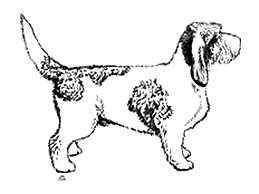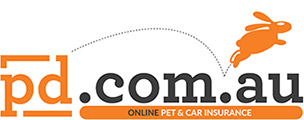Breed standards
Grand Basset Griffon Vendeen
Breed standards are the official guidelines that describe the ideal characteristics, temperament, and appearance of a breed and ensures that the breed is fit for function with soundness essential.

The Grand Basset Griffon Vendeen is derived, like all bassets, from hounds of superior size in this case the Grand Griffon. The first selections were made at the end of the 19th century by Comte d’Elva who was looking for subjects with straight legs. But it was Paul Dezamy who was especially responsible for fixing type. He understood that in order to catch a hare, dogs of a certain size were needed. He fixed that size at about 43 cm. Today used primarily when hunting with a gun, it is capable of hunting all furry game, from the rabbit to wild boar. A team of Grand Bassets won the 5th edition of the European Cup for hare.
Slightly elongated overall, it has straight forelegs, the structure of a basset, and must not resemble a small Briquet. It is balanced and elegant.
It is the perfect assistant for the hunter with a gun in territories of moderate size. Fastest of all scenthound bassets, tenacious, courageous, and a little stubborn. It must, from an early age, be accustomed to obeying; its training implies will and punishment, for which he will bear no grudge.
Behaviour: Fast, well voiced, a passionate hunter, courageous, loves bramble and scrub.
Temperament: A little stubborn but nevertheless well behaved. It is up to the master to take command.
Skull: Without heaviness, convex, elongated and not too wide, well chiselled below the eyes. Occipital bone well developed.
Stop: Frontal indentation well defined.
Nose: Prominent. Nostrils well open. Black and developed, except for white and orange coats where a brown nose is tolerated.
Muzzle: Square at its extremity, noticeably longer than the skull, very slightly convex.
Lips: Quite pendulous, covering well the lower jaw and giving the front of the muzzle a square profile. They are well covered with moustaches.
Of oval shape, large, dark, not showing white; friendly and intelligent expression. The conjunctiva must not be apparent.
Supple, narrow and fine, covered with long hair and ending in an elongated oval, well turned inwards. Low set, below the eye. They must be able to reach beyond the end of the nose.
Jaws strongly developed, scissor bite.
Long, robust and well muscled. Strong at set-on. Without dewlap.
Bone structure developed but lean. It should be understood that bone quality is not a question of volume but density.
The forequarters must be straight with a thick forearm and a very slightly defined but very solid carpal joint (wrist).
Shoulder: Long, clean and oblique.
Elbow: Should be neither too close to body nor too loose.
Forearm: Thick, wrists (carpus) should never touch.
Really that of a basset but avoiding an exaggerated length.
Back: Long, broad and really straight, never saddle-backed, and starting to arch its junction with the loin. Withers very slightly protruding.
Loin: Solid, well muscled, slightly arched.
Chest: Quite broad and well let down to elbow level.
Ribs: Rounded, never flat nor cylindrical. Thorax slightly less broad at elbow level to facilitate the movement.
Flank: Rather full, belly never tucked up.
Skin: Quite thick, often marbled in the tricoloured subjects.
Solid and well directed in the axis of the body.
Hip (Iliac crest): Apparent
Thigh: Strongly muscled but not too rounded, bone structure and articulations very solid.
Hock: Wide and angulated, must never be straight. Seen from the rear, it should not appear turned outwards or inwards.
Strong and tight with hard pads and solid nails. Good pigmentation of pads and nails is desirable.
Thick at the base, tapering progressively, set quite high, carried sabre fashion or slightly curved but never on the back or bent at the tip. Rather long.
The dog in action must give an impression of resistance and ease; the movement must be free and harmonious.
Hard, not too long and flat, never silky or woolly. The fringes should not be too abundant, the belly and inside of the thighs must not be bare. Eyebrows well pronounced but not covering the eye.
Black with white spotting (white and black). Black with tan markings (black and tan). Black with light tan markings. Fawn with white spotting (white and orange). Fawn with black mantle and white spotting (tricolour). Fawn with black overlay. Pale fawn with black overlay and white spotting. Pale fawn with black overlay. Traditional names: hare colour, wolf badger, badger colour or wild boar colour.
Height at withers:
Males from 40-44 cm
Females from 39-43 cm
With a tolerance of 1 cm more or less.
Any departure from the foregoing points should be considered a fault and the seriousness with which that fault should be regarded should be in exact proportion to its degree and its effect upon the health and welfare of the dog.
Head:
- Too short
- Flat skull
- Short muzzle
- Depigmentation of the nose, lips or eyelids
- Pincer bite
- Light eye
- Leathers set high, short, insufficiently turned in or lacking hair
Body:
- Too short or too long
- Lacking harmony
- Topline insufficiently firm
- Slanting rump
Tail:
- Deviated stern
Limbs:
- Insufficient bone structure
- Angulation too straight
- Hocks too close
- Slack in pasterns
Coat;
- Insufficiently dense, fine hair
Behaviour:
- Timid subject
ELIMINATING FAULTS:
- Aggressive or overly shy
- Lack of type
- Prognathism (overshot or undershot mouth)
- Wall eye. Eyes of different colours (Heterochromia)
- Lack of room in sternal region; ribs narrow towards the lower part.
- Kinky tail
- Crooked or half crooked forelegs
- Woolly coat
- Self coloured coat black or white.
- Important depigmentation
- Size outside the standard
- Noticeable invalidating point. Anatomical malformation.
Any dog showing physical or behavioural abnormalities shall be disqualified.
Male animals should have two apparently normal testicles fully descended into the scrotum.



